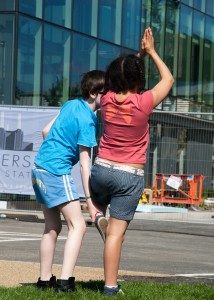Welcome to the latest in a series of guest posts from the ORP Library. Today we feature an article by Amanda Ronan entitled “Fostering Emotional Connections with your Child who has Autism“. Ronan is a writer, an editor, an educator and a dreamer. She has her Master’s in Education and was a teacher of elementary and middle-school aged children for nearly ten years. While engaged with her work in the classroom, Ronan rediscovered her first love — writing.
The baby photography package seemed like an over-the-top gift from her in-laws. Briana* didn’t think the family needed pictures of James in different outfits playing with different toys. She’d already posted plenty of those kinds of pictures on Facebook. In the end, though, the baby photographer ended up capturing some stunning shots of James, looking right into the camera while smiling and laughing. Now, when Briana looks at those photos, she is grateful for the gift; the photographer was able to capture a time when James was still engaged in the world around him in typical ways. Not long after that photo shoot, when James was nearly 18 months old, he stopped making eye contact. He stopped giggling when Briana tickled him. He stopped babbling. Suddenly, Briana’s lively, active, and loving baby seemed withdrawn and distant, heartbreakingly indifferent to Briana’s presence.
After a slew of visits to multiple doctors, including appointments to check his eyes and hearing, James was officially diagnosed with Autism Spectrum Disorder (ASD). The news changed Briana’s life forever; the loss she felt when she realized her son would likely never engage with her as he once had — easily, with smiling eyes and playful giggles — was devastating. There were nights Briana pored through that photo album, wondering what she had done wrong, wishing for the past.
As James grew, he continued to be less emotionally connected to the family than Briana’s other children. When they visited the town’s annual fall festival, James would wander off to investigate something that caught his eye, rather than stay close to the family and choose a pumpkin to decorate later. During the holidays, while the family decorated the house, trimmed the tree, and sang carols, James sat on the couch with his headphones on, watching a video on his tablet. For years, it seemed there was nothing Briana could do to encourage James to participate in the family life she and her husband tried to nurture.
Perhaps you currently find yourself in the same position as Briana. Your once happy, cooing, engaged baby is now reserved and distant because of ASD. As a caretaker, you feel as though there’s more you should be doing to help your child engage with your family. Yet so many of your efforts seem ineffective, leaving your child unaffected and disinterested — and your heart broken.
In those moments, it may be difficult to remember that your child is not choosing to be disconnected from you and your family; rather, he or she just doesn’t know how to connect the way you you would like him to. The good news is that many families have had success reestablishing strong emotional connections with their children with ASD. Children with ASD react differently to different environments, stimuli, and therapies, and such connections often happen in unexpected ways and through previously unconsidered activities.
The best way to begin rebuilding your emotional connection to your child is to work with teachers and therapists who have experience working with children with ASD. Professionals can model and teach you different therapeutic strategies and approaches to help foster connections with your child. Here are a few approaches, based upon the DIR/Floortime® model, to consider:
Floortime®. Floortime is a type of developmental therapy that pushes children with Autism Spectrum Disorder to reach their fullest communication potential. Floortime uses playful interactions to mobilize development in areas associated with attention and regulation, two-way communication, and social problem-solving. According to Autism Speaks, “Its premise is that adults can help children expand their circles of communication by meeting them at their developmental level and building on their strengths.” During Floortime, parents engage with their child in activities initiated and enjoyed by the child, rather than vice versa. For example, a child might enjoy blowing bubbles over playing with blocks; during Floortime, a parent would blow bubbles with the child, eventually establishing and nurturing communication through the game, rather than pushing an activity that will become frustrating to both parent and child. Floortime allows parents to better understand their child’s likes and dislikes. Many psychologists, teachers, and therapists are trained in Floortime techniques and can help parents include it in their child’s daily routine.
Pay attention to and understand your child’s specific cues and triggers. All children give nonverbal cues as to how they’re feeling, and your child with ASD is no different. Pay close attention to the sounds, facial expressions, and small gestures your child makes when he is hungry, tired, or content. The more you are able to predict what your child wants or needs, the more responsive you will become, and the greater the trust built between you — as well as the greater the emotional connection. In the same way that understanding cues can build a connection, your misunderstanding of what your child is communicating can easily lead to meltdowns or tantrums. Your child may feel ignored and frustrated when you don’t pick up on the right cues. Likewise, it is also important to pay attention to triggers for your child’s behavioral problems. Common triggers are often environmental, internal, or interactional. Understanding what triggers challenging behavior and meltdowns in your child will make you more responsive and your relationship stronger, especially as you are reacting purposefully and in response to their cues.
Understand your child’s individual differences in sensory processing. Many children with ASD are sensitive to lights, sounds, tastes, smells, and/or textures. What other children may find soothing or calming may irritate a child with ASD. Finding fun activities to do as a family that elicit positive responses, and take into account sensory sensitivities, can make for improved emotional connections and enjoyment. Some families, for example, have found that swimming calms their children with ASD, and allows them to be better regulated, which enhances quality family time. In fact, sometimes the floating sensation has such a positive impact on the child that he or she will allow for hugs and closeness in the water — a huge boon for a parent longing to connect with their child. Some children with ASD love swinging, so families have installed playground equipment in their backyards. Taking turns pushing the child sparks delight in both parent and child. Likewise, a parent might notice that their child is easily distracted and agitated around loud noises. This family then would try to avoid loud, highly stimulating social trips. A day-long outing at the county fair would then be off limits.
Through therapy, you can learn how to engage with your child. Through observing speech and occupational therapists’ methods of interaction with her son, for example, Briana can start to incorporate more of the things James enjoys in her own interactions with him. Instead of expecting him to join in the family fun, Briana can strive to bring the family into James’s idea of fun. Establishing emotional connections with your child with ASD may at times seem impossible, but with the right perspective, understanding, and tools, you too can experience a positive — even joyful — change.
For more information on DIR and Floortime, visit the ICDL website.
*Briana’s story is based on multiple interviews with parents of children with ASD.




